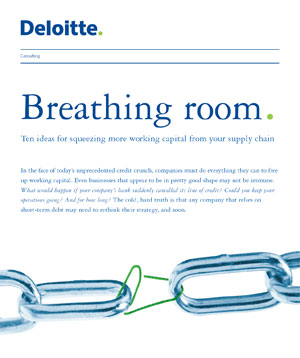Next from Terry Harris and Chicago Consulting, in another short report titled 10 Supply Chain Initiatives to Survive and Thrive this Downturn:
1. Re-Design Your Warehouse Network, Add Regional Warehouses and Save Transportation Costs: Your transportation costs are very dependent on your warehouse network-how many you have and where they are located. You can reduce transportation costs by adding regional warehouses.
2. Compete on Service, Fend Off Price Concessions: Your customers will evaluate their buying of your products in this downturn. They’ll place more demands on you and your competitors. Use this situation to compete on service rather than price.
3. Re-Bid Your Freight Spend, Deepen Your Routing Guide
4. Invest in Non-Transportation Resources - Inventory, Labor, Technology, Time - That Offset Transportation Cost: Supply chains are full of tradeoffs between resources; resources such as capital, labor, facilities, inventory, technology and so on. Increase the scope of one resource and you can decrease the scope of others.
5. Fill Orders Flexibly: You should get rid of fixed territories and ship orders flexibly. This means shipping orders based on costs and service. For example, large orders should likely come from plants, smaller orders from, say, a central DC and smaller still from regional DCs.
6. Change Inventory Management Logic - Set Safety Stocks and Order Quantities Differently: Make stocking/no-stock decisions and set Safety Stocks based on the cost of the item; change push deployment to pull; use smaller order quantities: This approach has historically encouraged many organizations to confront their set-up, changeover and acquisition costs.
7. Accelerate Your Forecasts to Catch-up with Decreased Demand: Sales history isn’t much of a guideline now. Get caught up with reality quickly.
8. Re-Engineer Packaging: Lots of opportunity for most companies.
9. Shift to More Productive Transportation Modes: Expedited to normal, parcel to LTL, LTL to TL, TL to rail, and air to ground.
10. Design Supply Chains and Position Products Around Green Sustainability
 From Justin Fogarty of procurement software vendor Ariba: From Justin Fogarty of procurement software vendor Ariba:
- Have you been honest with your buyers/suppliers about your financial situation? A little open dialogue and honesty can go a long way. If you’re a buyer in tough times, it may be worth discussing the situation with your strategic suppliers. Odds are good that they value your business and would feel some degree of financial pain themselves if you cut orders or in extreme cases…went under. So offering discounts or renegotiating terms may be preferable to the alternatives.
- Are you collaborating with your suppliers to identify production/material changes that would save money? Tata Motors is the perfect example of a company that leveraged the innovation and expertise of their suppliers to drive down costs. Tata focused on defining functional needs rather than stringent part specs and in doing so, the creativity of their suppliers paid off. Perhaps your own suppliers have ideas on how you can improve your products AND lower costs.
- Have you considered supply chain finance options? Changing payment terms can be a win/win for both parties and alleviate a great deal of financial pressure. After all, many profitable companies are struggling right now due to a lack of liquidity, not a lack of customers or even profitability. So a supply chain finance option that helps suppliers receive payment sooner and provides a discount to the buyer helps everyone involved.
We also liked this list from subscriber Tom Hall of VWR on ideas they are looking at to reduce distribution costs:
- For picking in our high rack area (we pick by outbound carrier), we're looking at increasing the number of picks per pallet
- Can we run fewer waves?
- Are there systematic things we can do to run more efficient waves so as to improve our pick paths?
- Can we introduce a cross-dock process for back-orders?
- Can we move operations from one area of the building to another to improve efficiency?
- We have a conveyor that drops down to 6-20 shipping lanes, depending on which facility you're in. Is there a way to consolidate work so that we need less shipping lanes?
- We have a Labor Management system and are looking to create more standards for functions that currently do not have standards tied to them.
- We're looking at processes like receiving and asking ourselves if we broke it and put it back together again, what would we really want it to look like.
Any thoughts on the above lists? Which ideas do you like best? Can you share your ideas or possible areas to look for savings/improvement? Let us know your thoughts at the Feedback button below. |